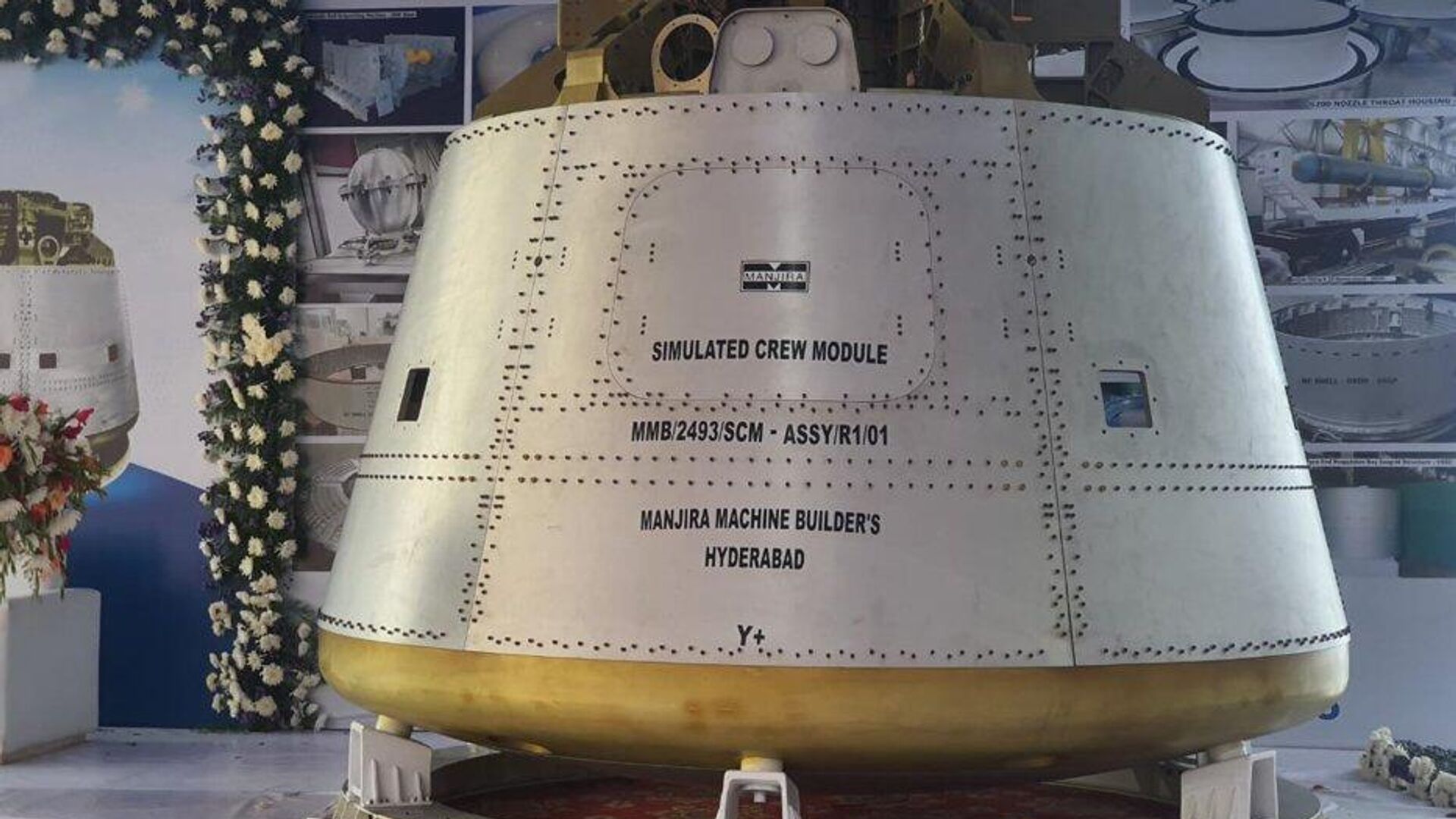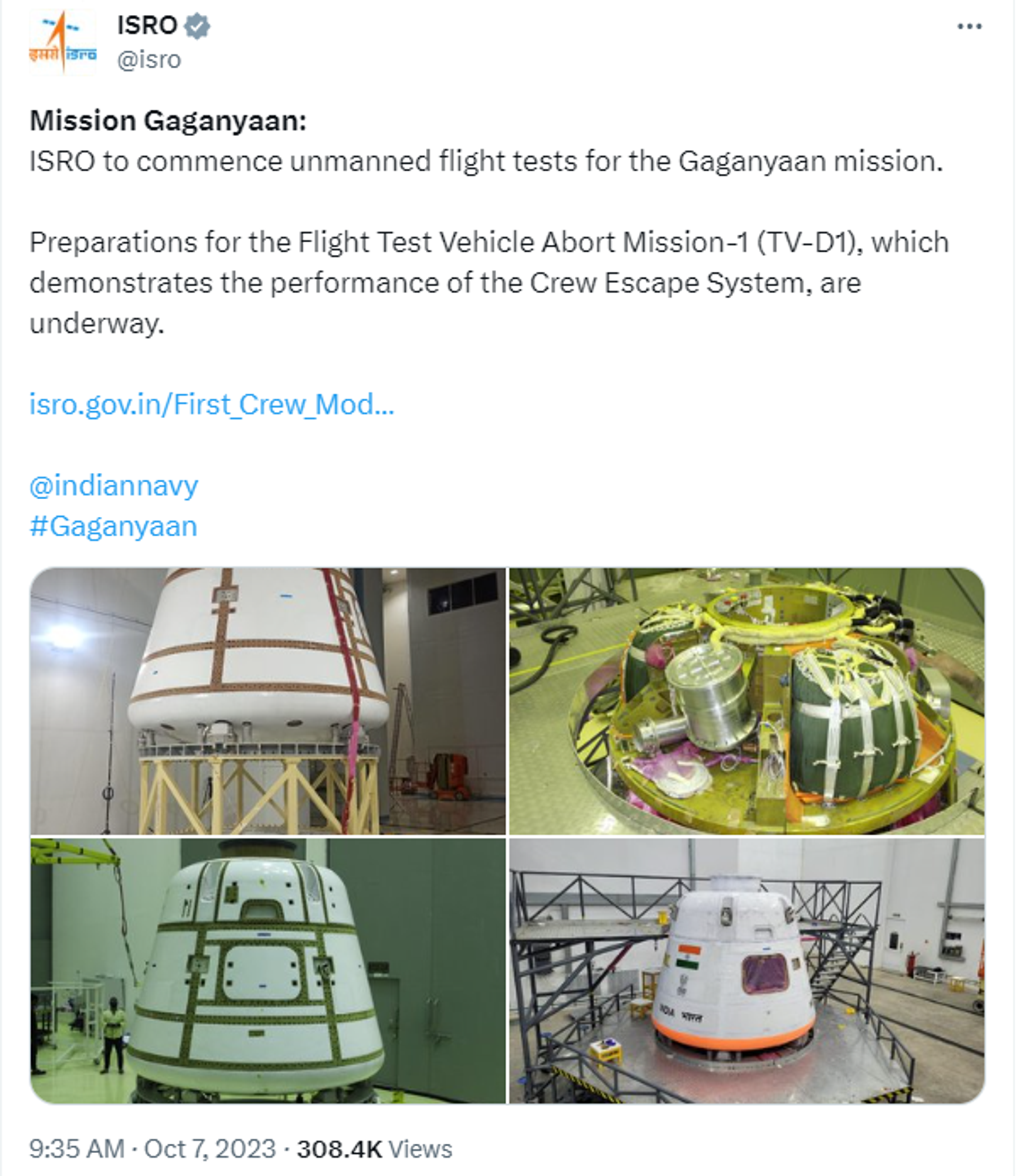https://sputniknews.in/20231007/isro-provives-first-glimpse-at-gaganyaan-spacecraft-4655454.html
ISRO Provides First Glimpse at Gaganyaan Spacecraft
ISRO Provides First Glimpse at Gaganyaan Spacecraft
Sputnik India
First pictures of Gaganyaan spacecraft which will take humans into space in December 2024, were released by the Indian Space Research Organisation (ISRO) on Saturday.
2023-10-07T14:30+0530
2023-10-07T14:30+0530
2023-10-07T19:59+0530
science & tech
india
space industry
indian space research organisation (isro)
chandrayaan
space satellite
space exploration
space rocket
human spaceflight
https://cdn1.img.sputniknews.in/img/07e7/06/16/2629690_0:88:933:613_1920x0_80_0_0_7e1f6acec201fe533b2ca26a616c4804.jpg
First pictures of Gaganyaan spacecraft which will take humans into space in December 2024, were released by the Indian Space Research Organisation (ISRO) on Saturday.In a tweet, the Indian space agency announced the release of images and shared their ongoing preparations for the Flight Test Vehicle Abort Mission-1 (TV-D1). This mission aims to showcase the exceptional performance of the Crew Escape System.Unmanned flight tests for the mission will start soon.The project would demonstrate the country's potential to take a crew of two to three members into a circular orbit of about 400 km around the Earth for a one to three day mission and return them safely to Earth by landing at a designated site in the Indian Ocean.In a press release, the ISRO said: “The Test Vehicle is a single-stage liquid rocket developed for this abort mission. The payloads consist of the Crew Module (CM) and Crew Escape Systems (CES) with their fast-acting solid motors, along with CM fairing (CMF) and Interface Adapters. This flight will simulate the abort condition during the ascent trajectory corresponding to a Mach number of 1.2 encountered in the Gaganyaan mission.”Notably, India's Minister of Science and Technology, Jitendra Singh, had informed Parliament on 21 December 2022 that the uncrewed 'G1' [Gaganyaan 1] mission would be launched in the last quarter of 2023, followed by the second uncrewed 'G2' [Gaganyaan 2] mission in the second quarter of 2024, before the final manned 'H1' mission in the fourth quarter of 2024.
https://sputniknews.in/20231006/india-soon-to-have-its-own-space-station-isro-chief-4633312.html
india
Sputnik India
feedback.hindi@sputniknews.com
+74956456601
MIA „Rossiya Segodnya“
2023
Rahul Trivedi
https://cdn1.img.sputniknews.in/img/07e6/0c/13/136500_0:0:628:627_100x100_80_0_0_72097ff894c7446b70d2efafcb719720.jpg
Rahul Trivedi
https://cdn1.img.sputniknews.in/img/07e6/0c/13/136500_0:0:628:627_100x100_80_0_0_72097ff894c7446b70d2efafcb719720.jpg
News
en_IN
Sputnik India
feedback.hindi@sputniknews.com
+74956456601
MIA „Rossiya Segodnya“
Sputnik India
feedback.hindi@sputniknews.com
+74956456601
MIA „Rossiya Segodnya“
Rahul Trivedi
https://cdn1.img.sputniknews.in/img/07e6/0c/13/136500_0:0:628:627_100x100_80_0_0_72097ff894c7446b70d2efafcb719720.jpg
first pictures of gaganyaan spacecraft, isro, indian space research organisation, flight test vehicle abort mission-1 (tv-d1), crew escape system, soon the unmanned flight tests for the mission will start, the test vehicle, fast-acting solid motors, cm fairing, interface adapters, isro's facility in bengaluru, indian astronauts, science and technology minister jitendra singh, g1, gaganyaan 1 mission, g2, gaganyaan 2 mission, h1 mission
first pictures of gaganyaan spacecraft, isro, indian space research organisation, flight test vehicle abort mission-1 (tv-d1), crew escape system, soon the unmanned flight tests for the mission will start, the test vehicle, fast-acting solid motors, cm fairing, interface adapters, isro's facility in bengaluru, indian astronauts, science and technology minister jitendra singh, g1, gaganyaan 1 mission, g2, gaganyaan 2 mission, h1 mission
ISRO Provides First Glimpse at Gaganyaan Spacecraft
14:30 07.10.2023 (Updated: 19:59 07.10.2023) On August 15, 2018, Prime Minister Narendra Modi declared "an Indian son or daughter will undertake a manned space mission on board 'Gaganyaan', carrying the national flag".
First pictures of Gaganyaan spacecraft which will take humans into space in December 2024, were released by the Indian Space Research Organisation (ISRO) on Saturday.
In a tweet, the Indian space agency announced the release of images and shared their ongoing preparations for the
Flight Test Vehicle Abort Mission-1 (TV-D1). This mission aims to
showcase the exceptional performance of the Crew Escape System.
Unmanned flight tests for the mission will start soon.
The project would demonstrate the country's potential to take a crew of two to three members into a circular orbit of about 400 km around the Earth for a one to three day mission and return them safely to Earth by landing at a designated site in the Indian Ocean.
In a press release, the
ISRO said: “The Test Vehicle is a single-stage liquid rocket developed for this abort mission. The payloads consist of the Crew Module (CM) and Crew Escape Systems (CES) with their fast-acting solid motors, along with CM fairing (CMF) and Interface Adapters. This flight will simulate the abort condition during the ascent trajectory corresponding to a Mach number of 1.2 encountered in the Gaganyaan mission.”
They further added that ''the Crew Module after integration underwent various electrical testing at ISRO's facility in Bengaluru, including an acoustic test and was dispatched to SDSC-SHAR on August 13.''
“The success of this test flight will set the stage for the remaining qualification tests and unmanned missions, leading to the first Gaganyaan mission with Indian astronauts,” the
space agency stated.
Notably, India's Minister of Science and Technology, Jitendra Singh, had informed Parliament on 21 December 2022 that the uncrewed 'G1' [Gaganyaan 1] mission would be launched in the last quarter of 2023, followed by the second uncrewed 'G2' [Gaganyaan 2] mission in the second quarter of 2024, before the final manned 'H1' mission in the fourth quarter of 2024.




